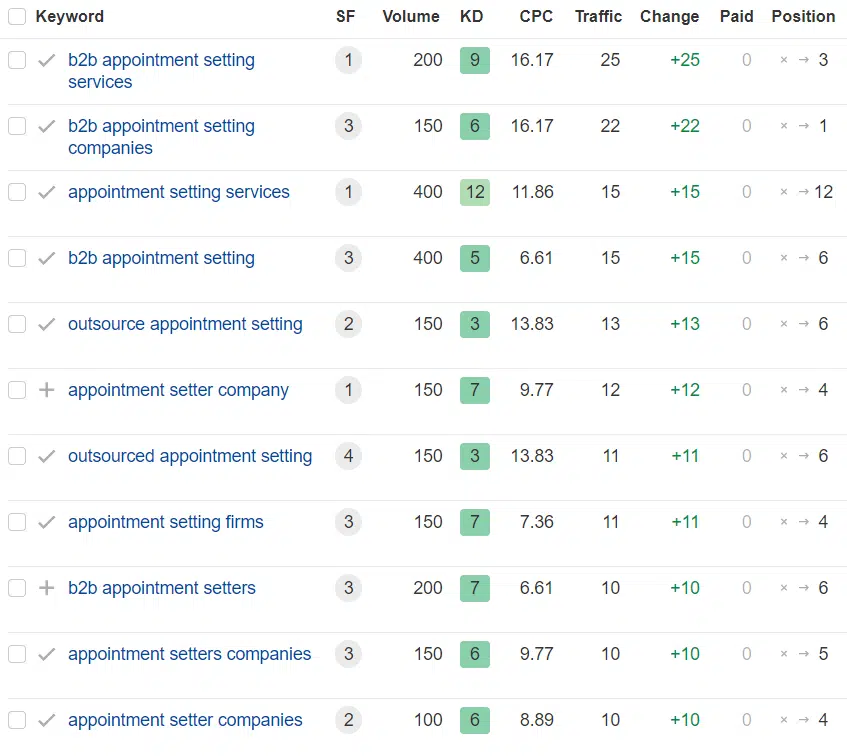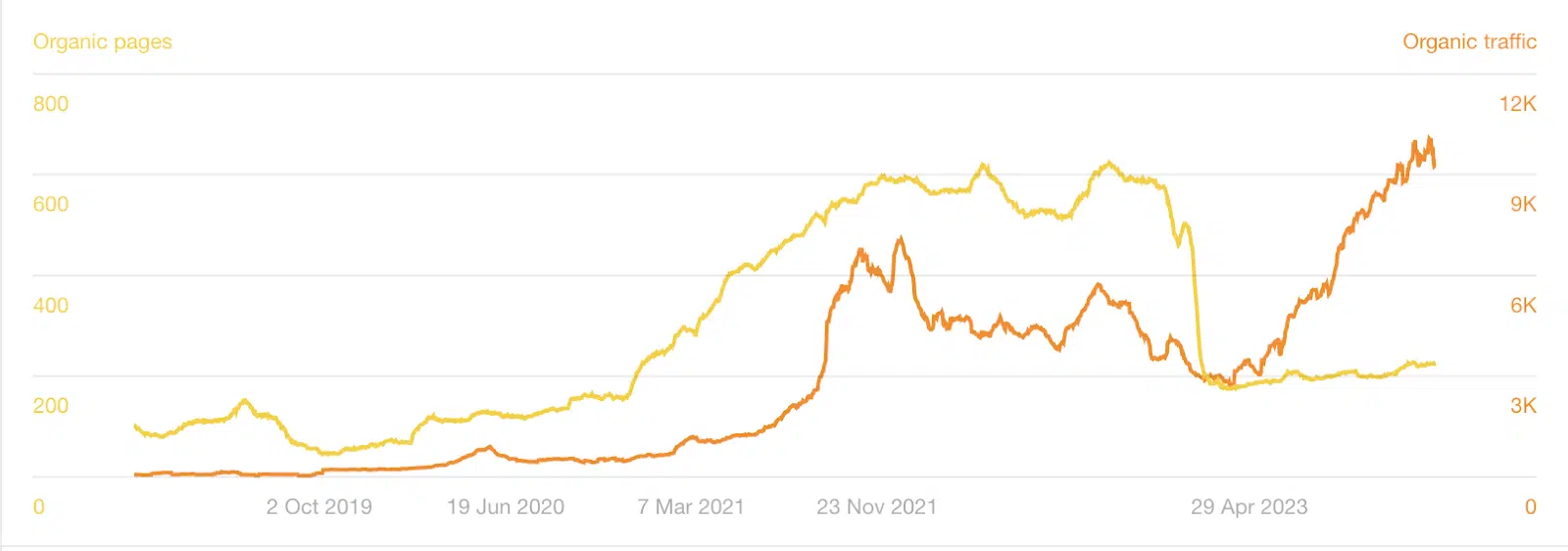Why bottom-of-the-funnel SEO is the game-changer your B2B needs
BOFU SEO focuses on high-intent keywords to attract prospects ready to convert. Learn how to create content for ready-to-buy prospects.
Too often, companies focus SEO efforts on driving traffic with top-of-the-funnel content and keywords. While this approach can generate traffic, it often fails to convert them into leads and sales. In B2B, the opportunity is in optimizing for bottom-of-the-funnel queries and conversions.
Let’s delve into how we turned our agency’s SEO strategy upside down and generated revenue as a result.
So, why start from the bottom in B2B?
From my perspective, there are several key reasons.
Higher conversion rates
The bottom-of-the-funnel (BOFU) content is all about conversions. People who come from it are already looking for a solution, not a definition.
And yes, while niche content traffic may be low, conversions can be high.
For instance, we got eight clicks on a page about the SDR approach, which ranked for the “SDR team outsource” keyword, and two opportunities came from it.
But our best example is the article “The 7 best B2B appointment setting companies in 2023,” which shot to Position 1 in less than four months. Moreover, it brought us 19 highly qualified leads and 10 conversions to opportunities from it.

We analyzed why this article could take off, and one of the reasons is that when we published it, we already had up to 15 articles and a robust link-building strategy focused on “appointment setting” anchors. We already rank in many lists like “best appointment setting companies.”
Displaying in-depth coverage of a topic from various angles is crucial to show Google that we are an authoritative source. Since we have been discussing appointment setting extensively, it’s possible that Google recognized us as an expert in this niche, which could have contributed to our new post receiving a higher ranking.
Less intense competition and the right intent
More specific keywords are easier to move to the top, as there are almost no competitors fighting for them. Take an example of the keyword our article ranks first for:

You can also see that the search intent for this keyword is commercial. A person who looks it up is in the market to spend money. To convert them, you need to speak their language, address their pain points, and answer their questions. Thus, you’ll be able to build trust with prospects and streamline their decision-making.
Potential risk alert: If you create lists of competing companies in your niche, be prepared to hand them leads. Users might click all the options, compare offers, and convert with someone else on your list, not you.
Where can top-of-the-funnel content come in handy?
Don’t get me wrong, it’s not that you should produce only bottom-of-the-funnel content. It’s always about a complex strategy to address the needs of each potential customer at each stage of their lifecycle in your pipeline. Top-of-the-funnel (TOFU) content can be useful to:
- Build your brand awareness. If a person comes across your content or even subscribes to your updates, they will get acquainted with you. Thus, you get a chance to introduce your services to a broader audience and establish yourself as an industry expert.
- Get more leads. It works great when someone googles a TOFU keyword and then downloads your lead magnet. Thus, you can grow your lead database and qualify and nurture them. You can even convert them into paying customers in the long run.
- Showcase authority on the subject. It’s easier to get to the top if a company becomes a topical authority in Google’s eyes. That is if you constantly create high-quality content with research conducted better than that of competitors. You can’t win traffic and top positions by using only the BOFU content. You need to cover the topic fully, including the basics like “what is…” and so on.
Moreover, you can even alienate potential customers in earlier stages of the funnel by only catering to those ready to buy. The math is simple: If you don’t create TOFU content, then you won’t get more generic traffic. So, the question isn’t whether or not to write these texts at all. The question is whether you need it right now. This is about priorities.
For instance, at the moment, our agency wants revenue. And this potential revenue lies with people who are ready to spend money. So it’s better for us to quickly get customers willing to purchase our services or whose needs we can cover. Those who are not yet mature are also interesting to us, but we save them for later. In the future, we also plan to move into TOFU content. But first, we want to prepare all the BOFU content related to our niche.
Dig deeper: A B2B marketer’s guide to long-form content
How to get bottom-of-the-funnel SEO right
Each case is different, for sure. However, you can still use some common tactics and techniques to make your BOFU strategy work.
Keyword research focused on purchase intent
Keyword research isn’t something you’ve done once and can settle with that. Lots of both external and internal factors change and you can’t help but evolve with them.
To keep up with the market and stay relevant for your potential clients, use these techniques for identifying high-intent keywords:
- Hear your leads and clients out. This is your go-to strategy. Conduct user interviews or ask your sales team to record calls with clients. Listen to all the calls, gather insights, and then use those insights to research keywords. This is the most effective way to identify non-trivial problems you can solve. In some cases, they may even give you the idea for a new product, service, or market.
- Use specialized tools. The best one is your Google Search Console, as it provides real and up-to-date data. Ahrefs and similar tools are another good option, but they are more likely to “guess” the right keywords. The point is they draw them from purchased databases, which are not updated in real time. Even if you don’t have any tools or a search console, Google is still the best way to collect relevant queries. You can check Google autocomplete suggestions. Or check the section “People also ask” (PAA) in search results.
- Analyze your competitors’ sites. Another way to identify relevant keywords is to look at the keywords that your competitors are ranking for. Simply scrape their keywords and consider whether they are relevant to your offer in the market.
Creating tailored content
Create landing pages, lists, and lead magnets that address specific pain points and offer immediate solutions. Think case studies, comparisons, and expert guides.
An easier way to go here is to add a block addressing your prospects’ challenges to your homepage or service pages:

You can also create a separate landing page with a unique structure for each of your services.
As for BOFU lead magnets, consider preparing something like a scorecard for lead generation agency evaluation. These magnets are designed to appeal to hot leads considering working with a particular company.
However, it is important to test different content formats to see what works best for your company or niche. For example, if someone searches for “B2B sales outsource,” you don’t know if they are looking for how-to information, should-I-or-shouldn’t-I advice, a list of companies, or a specific service.
The best way to convert this person is to create content that addresses all of these potential needs, including middle-of-the-funnel (MOFU) and top-of-the-funnel content.
Optimizing for conversions
Regularly review and upgrade the design of your landing pages to make calls to action clearer and the copy — more persuasive. Use A/B testing to refine your approach and maximize conversions. Come up with different ways to book a call or demo with your prospect.
A good option here is to add highly converting blocks for warm and hot leads. For example, to capture people coming to your website from the review platforms, you can add a lead form that instantly books a call with your sales execs:

Finally, a few more tips from our experience.
We didn’t start as well as we would have liked, primarily because we inherited a legacy site with a ton of content (over 600 pages). But it was all TOFU content, turning our website into a sales glossary and job description templates. We reduced the size of our site twice and focused on quality BOFU content, only to see an increase in organic traffic and (spoiler alert) conversions.

Here’s what we did:
- Deleted the pages with little potential, like job descriptions.
- Focused on queries that close the pain points of our customers and, therefore, have potential purchase intent.
- Started writing more experience- and expertise-level content that you won’t find in Google.
- Tuned the technical side of the site, namely improved the Core Web Vitals indicators, fixed errors, improved user experience, etc.
As a result of these efforts, we reached a 7% conversion rate from blog posts, which is only growing.
Integrating bottom-of-the-funnel SEO into the overall marketing strategy
BOFU SEO isn’t an isolated standalone tactic. It’s a strategic shift that complements your marketing efforts. While it focuses on attracting high-intent leads, TOFU content still plays a role in building brand awareness in the early stages and MOFU content nurtures you leads down the funnel. The key is to find the right balance and prioritize content that immediately impacts your sales goals.
But to get the most out of your bottom-of-the-funnel strategy, make sure to align it and reuse content in other channels.
Social media
If your target audience is on LinkedIn and follows your founder, why shouldn’t they share your new piece of BOFU content? This is a great way to reach a wider audience and generate more engagement.
You could even create a series of posts that promote your content and offer valuable insights or tips. Include a call to action to encourage people to click through to your website or subscribe to your email list and you’re getting a chance to grow your database. As an option, you can launch lead magnet ads on LinkedIn to get your prospects’ contact details.
Also, find relevant discussions in relevant communities and answer questions with your content.
Email sequences
Another way to leverage alternative channels is to use email marketing. This is a great way to deliver your content directly to your target audience. When creating email campaigns for your BOFU SEO content, be sure to personalize the messages and include a clear call to action. You can also use email marketing to promote your lead magnets and other conversion-focused content.
Although this does not generally affect organic search, it is definitely important to distribute BOFU content on different channels to boost your marketing strategy.
So try it, and may the force of quality expert content be with you!
Dig deeper: The power of curated content in B2B marketing
Opinions expressed in this article are those of the guest author and not necessarily MarTech. Staff authors are listed here.
Related stories